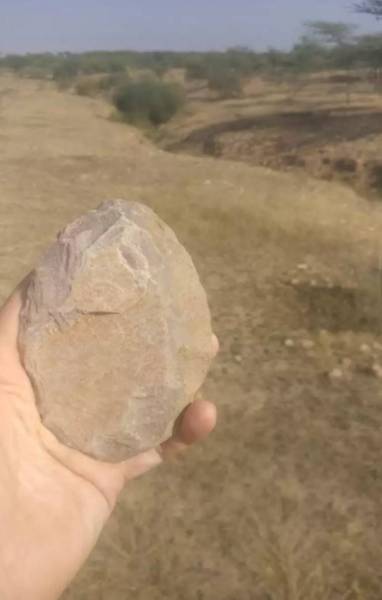
[ad_1]
Populations of ancient humans using Acheulean stone tools persisted in India until around 177,000 years ago, shortly before the first expansions of our own species, Homo sapiens, across Asia, according to a study released Wednesday.
The oldest tool-making tradition in prehistoric times, known as the Acheulean, was characterized by oval and pear-shaped stone axes and choppers associated with Homo erectus and derivative species such than Homo heidelbergensis.
The latest research by the Max Planck Institute for the Science of Human History in Germany reexamined a key Acheulean site on the fringes of the monsoon zone in the Thar Desert, Rajasthan.
Absolutely delighted to have a new paper in @SciReports with Prof. Hema Acyuthan, @durcanjulie, @ paleotropics and Dr Jana Ilgner demonstrating the late persistence of Acheulean occupations in Singi Talav (India) and revealing their ecological context https://t.co/Ev9cOQrvdd 1 / n
– Jimbob Blinkhorn (@palaeolicious) October 5, 2021
The study, published in the journal Scientific reports, shows the presence of Acheulean populations until about 177,000 years ago, shortly before the first expansions of Homo sapiens across Asia.
The timing and route of the first expansions of our own species across Asia has been the subject of considerable debate. However, more and more evidence indicates Homo sapiens interacted with many populations of our evolutionary closest cousins, the researchers said.
Identifying where these different populations met is key to revealing the human and cultural landscape encountered by the first members of our species to expand beyond Africa, they said.
 An ax from the Thar Desert, where Acheulean populations persisted until at least 177,000 years ago. (Jimbob Blinkhorn via the Max Planck Institute for the Science of Human History)
An ax from the Thar Desert, where Acheulean populations persisted until at least 177,000 years ago. (Jimbob Blinkhorn via the Max Planck Institute for the Science of Human History)The researchers noted that although fossils from ancient human populations are extremely rare in South Asia, the modifications to the stone toolkits they made, used and left behind can help determine when and where these encounters. could have happened.
The latest research shows the relatively recent occupation of the Singi Talav site by Acheulean populations up to 177,000 years ago.
The site was once considered one of the oldest Acheulean sites in India, but now appears to be one of the youngest, researchers say. These dates show the persistence of Acheulean populations in the Thar Desert after their disappearance in East Africa around 214,000 years ago and in Arabia 190,000 years ago, they noted.
The study sheds light on the environmental conditions that allowed Acheulean populations to thrive on the monsoon fringes of the Thar Desert until at least 177,000 years ago.
“This confirms evidence from across the region that India has welcomed the younger populations using Acheulean toolkits across the world,” said Jimbob Blinkhorn of the Max Planck Institute for the Science of History. human, the lead author of the study. “Critically, the late persistence of the Acheulean in Singi Talav and elsewhere in India directly precedes the evidence for the appearance of our own species, Homo sapiens, in its expansion across Asia,” added Blinkhorn.
The researchers noted that the Singi Talav site, located by a lake near the modern town of Didwana on the edge of the Thar Desert, was first excavated in the early 1980s, revealing multiple assemblages of ‘stone tools.
The largest assemblage shows a concentration on the production of typical Acheulean stone axes and choppers, they said. However, the techniques necessary to accurately date these assemblages were not available at the time of their discovery.
“The lakeside setting provides ideal preservation conditions for an archaeological site, allowing us to go back 30 years after the first excavation and easily re-identify the main occupation horizons again,” said Blinkhorn.
The researchers used luminescence methods to directly date the sedimentary horizons occupied by ancient human populations. These methods rely on the ability of minerals like quartz and feldspar to store and release energy induced by natural radioactivity, allowing scientists to determine when the sediment was last exposed to light.
“Ours is the first study to directly date the occupation horizons at Singi Talav, allowing us to understand both when ancient humans lived here and created the stone tool assemblies, and how those occupations compare to other sites in the region, “said Julie Durcan of the University of Oxford in the UK.
The Thar Desert sits at the western edge of the modern Indian summer monsoon system, and its habitability for ancient human populations has likely fluctuated significantly. Researchers examined plant microfossils, known as phytoliths, as well as characteristics of soil geochemistry to reveal the ecology of the site at the time of production of the Acheulean toolkits.
“This is the first time that the ecology of an Acheulean site in India has been studied using these methods, revealing the broader character of the landscape inhabited by these populations,” said Professor Hema Acyuthan of the Anna University, Chennai, which also participated in the excavations. on the site. “The results of the two methods we applied complement each other to reveal a landscape rich in types of herbs that bloom during periods of heightened summer monsoons,” Acyuthan added.
[ad_2]
Source link